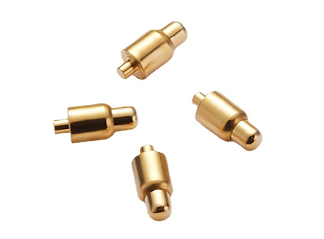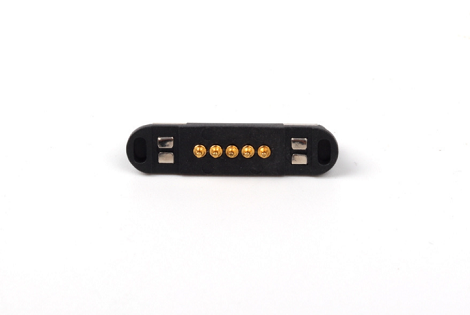Home > News

A pogo pin is an elastic connector typically made up of the following components:
Metal Pin: Serves as the electrical connection part, usually made of highly conductive materials like copper, alloys, or stainless steel.
Spring: The spring ensures a reliable connection between the pin and the target connection point by compressing and decompressing.
Outer Shell and Insulating Materials: Protects the metal components from corrosion and short circuits while providing structural support.
The working principle of a pogo pin relies on the elasticity of the spring inside it, which maintains a stable contact force between the pin and the contact point. As a result, the temperature tolerance of pogo pins must consider not only the high-temperature and low-temperature performance of the materials but also the changes in the spring's elasticity with temperature, as well as the effects of thermal expansion in the materials.
The temperature tolerance of a pogo pin generally depends on the materials used and the design of the pin. Different manufacturers may produce pogo pins with varying specifications, but most are designed to withstand certain temperature ranges. The primary factors that influence the temperature tolerance of pogo pins include:
The metal parts of a pogo pin, such as the pin and spring, are crucial in determining its temperature tolerance. Common materials and their temperature capabilities include:
Copper and Copper Alloys: Copper is known for its excellent electrical conductivity but has relatively low temperature tolerance. Typical copper alloys, such as brass, are generally rated for temperatures between -20°C and +120°C. Beyond this range, copper may suffer from oxidation, deformation, or damage.
Stainless Steel: Stainless steel, commonly used for the spring in pogo pins, has excellent corrosion resistance and better high-temperature performance. Common stainless steels like 304 and 316 can typically withstand temperatures ranging from -50°C to +100°C. For example, 304 stainless steel can endure temperatures from -50°C to +100°C, while 316 stainless steel can withstand temperatures from -50°C to +100°C. Therefore, pogo pins using stainless steel are suitable for higher temperature environments.
Alloy Materials: Certain special alloys, such as nickel-titanium alloys and molybdenum alloys, can perform at higher temperatures. For example, nickel-titanium (NiTi) alloys can function effectively within a temperature range of -50°C to +100°C.
The spring is one of the most critical parts of a pogo pin, and its elasticity and reliability directly impact the electrical connection. The material of the spring is key to determining the temperature tolerance. Common spring materials include:
Steel Springs: Steel springs may experience a reduction in elasticity at higher temperatures, leading to unstable connections. Steel springs typically operate in a temperature range from -40°C to +150°C.
Titanium and Nickel Alloy Springs: Springs made from titanium or nickel alloys maintain better elasticity at higher temperatures and can perform well in environments ranging from -50°C to +200°C.
Insulating materials in pogo pins are used to protect the metal parts, enhance electrical performance, and prevent short circuits. Common insulating materials include epoxy resin, polyimide (PI), and polytetrafluoroethylene (PTFE).
Polyimide (PI): Polyimide is a high-temperature insulating material with excellent thermal stability. Its temperature range typically spans from -200°C to +300°C, making it ideal for protecting pogo pins from high-temperature environments.
Polytetrafluoroethylene (PTFE): PTFE is chemically stable and highly resistant to high temperatures. Its temperature range usually extends from -200°C to +260°C. PTFE’s excellent electrical properties and high-temperature resistance make it a preferred insulating material for pogo pins.
Pogo pins often operate in environments with fluctuating temperatures. In such situations, temperature variations can cause the pogo pin to expand and contract, affecting the stability of the connection. Significant temperature differences could lead to material fatigue or deformation, which can impact its performance. Therefore, the design of pogo pins typically takes temperature fluctuations into account to ensure reliable long-term performance.
Pogo pins are well-suited for use in high-temperature environments. Some typical high-temperature applications include:
Electronic Product Testing: Pogo pins are often used in testing electrical connections on circuit boards. In high-temperature test environments (e.g., 150°C to 200°C), the choice of materials and design of the pogo pin is crucial, especially the temperature tolerance of the metals and the elasticity of the spring.
Automotive Industry: With the increasing complexity of automotive electronics, pogo pins are commonly used in automotive electronic systems, particularly in areas exposed to high temperatures (e.g., engine compartments). Automotive environments often involve high temperature and thermal shock, requiring pogo pins to be temperature-resistant and stable.
Aerospace: The aerospace industry has extremely stringent temperature requirements, and pogo pins are used in electrical connection devices in spacecraft. Since spacecraft can experience temperature variations ranging from -100°C to +150°C, pogo pins in this field must be designed to withstand these extreme conditions.
Military Applications: Military equipment often operates in environments with extreme temperature fluctuations. Pogo pins used in military applications must be capable of withstanding these temperature extremes to ensure the reliability and safety of the equipment.
Temperature significantly affects the performance of pogo pins, particularly when exposed to extreme conditions over long periods. Some of the key effects of temperature on pogo pin performance include:
Elasticity Changes: As temperature increases or decreases, the elasticity of the pogo pin’s spring material may change. High temperatures can weaken the elasticity of the spring, causing unstable connections, while low temperatures can make the spring brittle, increasing the risk of failure.
Electrical Conductivity Changes: The electrical conductivity of metals decreases as temperature increases. This can affect the performance of pogo pins, especially in high-speed data transmission applications.
Thermal Expansion Effects: Different materials have different coefficients of thermal expansion, and temperature fluctuations can cause dimensional changes in the pogo pin. In high-temperature environments, the metal parts may expand, potentially causing the spring to lose its elasticity and negatively affecting the contact force, leading to instability in the electrical connection.

By carefully selecting materials, precisely designing components, and controlling manufacturing processes, pogo pins can remain effective in a wide range of temperature conditions, ensuring reliable electrical connections in diverse industries.
Contact: Jerry_shi
Phone: +86-13652508770
Tel: +86-13652508770
Email: [email protected]
Add: ChanFu Dong Road,XiaoBian Village, ChangAn Town,DongGuan City,GuangDong,China